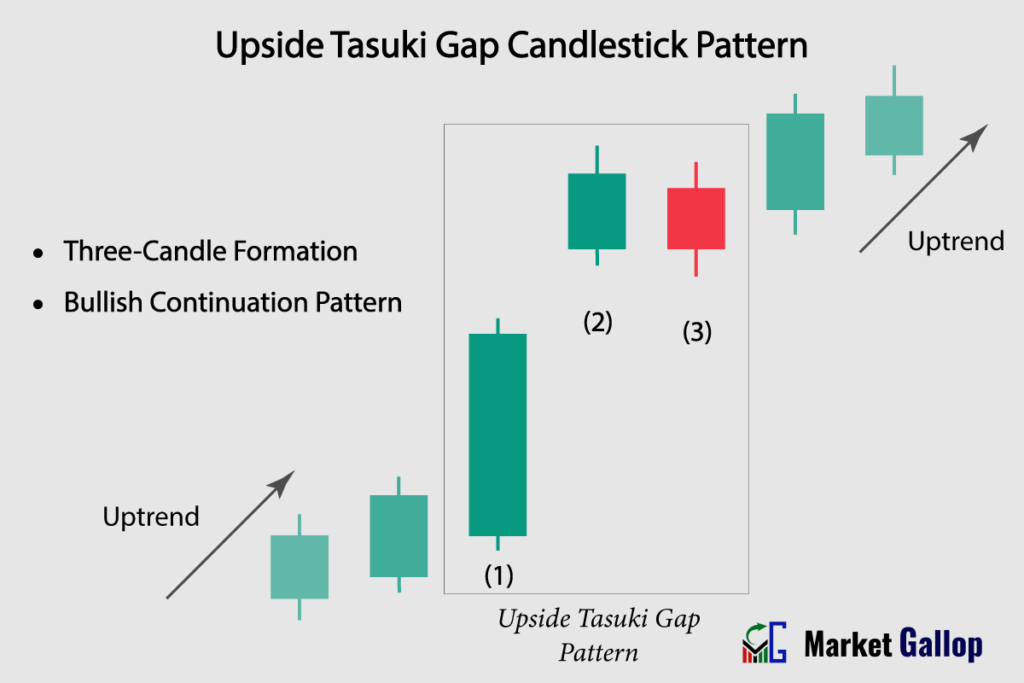The Upside Tasuki Gap Candlestick Pattern is a bullish continuation pattern that is a part of Japanese candlestick charting techniques. This pattern typically consists of three candlesticks and is often interpreted as a signal that an ongoing bullish trend is likely to continue.
The bullish implications of the Upside Tasuki Gap Pattern stem from the fact that the bearish attempt to reverse the trend is thwarted, indicating that buyers are still in control. This pattern is seen as a potential buying opportunity, suggesting that the bullish momentum is likely to continue after the brief consolidation or correction.
Upside Tasuki Gap Candlestick Pattern
The Upside Tasuki Gap is a bullish continuation candlestick pattern that occurs within a prevailing uptrend. This pattern is composed of a combination of three candlesticks: one long bullish candle followed by another small bullish candle that opens with a gap, and a third bearish candle that opens within the body of the second candle.
The pattern begins with a strong bullish candlestick, representing the prevailing uptrend. Following this, there is a smaller bullish candlestick that gaps up and closes higher than the previous long bullish candle. This smaller candlestick creates an “upside gap,” which is a gap between the closing price of the previous candle and the opening price of the current candle.
The third candlestick is a bearish candlestick that opens within the body of the second bullish candlestick and closes below it. This bearish candlestick’s attempt to fill the gap created by the second bullish candlestick signifies a temporary pause or correction within the trend. However, the inability of the bearish candlestick to completely close the gap suggests that the bullish sentiment remains strong.

Upside Tasuki Gap Pattern – Formation
The Upside Tasuki Gap pattern is a three-candle bullish continuation formation.
First Candlestick (Bullish): The first candlestick is a long bullish (green) candle that closes near its high price of the day.
Second Candlestick (Bullish): The second candlestick is a small bullish (green) candle that opens with a gap above the close of the first bullish candle. This candle, which gaps up on the open, is the one that creates the “upside tasuki gap.”
Third Candlestick (Bearish): The third candlestick is a small bearish (red) candle that opens within the body of the second bullish candle and closes below it. This third bearish candle has the potential to partially fill the gap created by the second bullish candle. However, it is unable to completely breach the gap, which functions as a support level.
Rules of Identification
Prior Trend: The market should be in a clear uptrend before the Upside Tasuki Gap pattern occurs.
First Candle: The initial candle should be a bullish (green) candlestick. This candle is of substantial length and must close near its highs, with relatively small or no shadows on either side.
Second Candle: The second candle should also be a bullish (green) candlestick. It opens with a gap above the first candle and closes higher. It is relatively smaller in comparison to the first candle.
Third Candle: The final candle should be a bearish (red) candlestick. This candle opens within the body of the second candle. It moves towards the gap below, and may partially fill the gap. It closes below the second candle; however, it is unable to completely fill the gap.
The Gap: The first and second candle creates a gap in between them. This gap acts as a resistance to the third bearish candle.
Color:The color of the first and second candles must be green. The color of the third candle is red.
Shadows: Small shadows on either side can be ignored.
Market Psychology
The pattern begins with a long green candlestick, suggesting a strong bullish sentiment and an established uptrend in the market.
Following the initial bullish candlestick, a smaller green candlestick appears that gaps up and closes higher than the previous long green candle. This signals that buyers remain active and willing to push prices higher, despite the preceding bullish move. This phase underscores the resilience of the bullish sentiment.
The pattern concludes with a bearish candlestick that opens within the body of the previous bullish candle and closes below it. Despite the appearance of a bearish candlestick, its inability to completely breach the gap suggests that the selling pressure is limited. If the window formed by the upside gap is not violated by the bearish candlestick’s low, it indicates that buyers are still maintaining their control.
The appearance of a bearish candlestick during the final phase is seen as a temporary pause in the bullish trend, rather than a reversal. Its inability to violate the gap, highlights the resilience of the bullish sentiment. If the window created by the gap remains intact, traders may view the appearance of the Tasuki Upside Gap Pattern as a potential buying opportunity.
How to Trade Upside Tasuki Gap Pattern
- Identify the Uptrend: Before looking for the Upside Tasuki Gap pattern, make sure there is a clear and established uptrend in the price chart.
- Wait for the Upside Tasuki Gap Pattern to Emerge: Wait for the completion of the pattern.
- Entry: Observe the next candle (i.e., the candle after the bearish candle) following the formation of the pattern. Entry is triggered when the fourth candle breaches the high of the bearish candle. However, more conservative traders should wait for the fourth candle to close. Entry is confirmed when the fourth candle closes above the highest high of the entire Upside Tasuki Gap pattern.
- Set Stop-Loss: Traders may set stop-loss below the gap or window formed between first and second bullish candles.
Traders are recommended to incorporate additional technical analysis tools, such as key support levels, trendlines, trading volumes, and technical indicators to confirm the potential reversal signal suggested by the Upside Tasuki Gap pattern.
Trigger: When the fourth candle breaches the high of the bearish candle
Confirmation: When the fourth candle closes above the highest high of the entire pattern.
Stop-loss: Just below the gap between first and second bullish candles.
Reliability of the Pattern
The reliability of the pattern increases when it occurs within a strong and well-established uptrend. Furthermore, if the gap is violated on the downside, it indicates strong selling pressure and renders the pattern invalid.
Combining the Upside Tasuki Gap pattern with other technical analysis tools, such as moving averages, trendlines, and momentum oscillators, can provide additional confirmation and enhance the reliability of the pattern.
Gallop Insights
For better results:
- Look for Upside Tasuki Gap pattern at key levels (support & resistance levels)
- Wait for confirmation of pattern, i.e., close of the fourth candle.
- The pattern should not be used in isolation. Use it in conjunction with other technical analysis tools and indicators.










